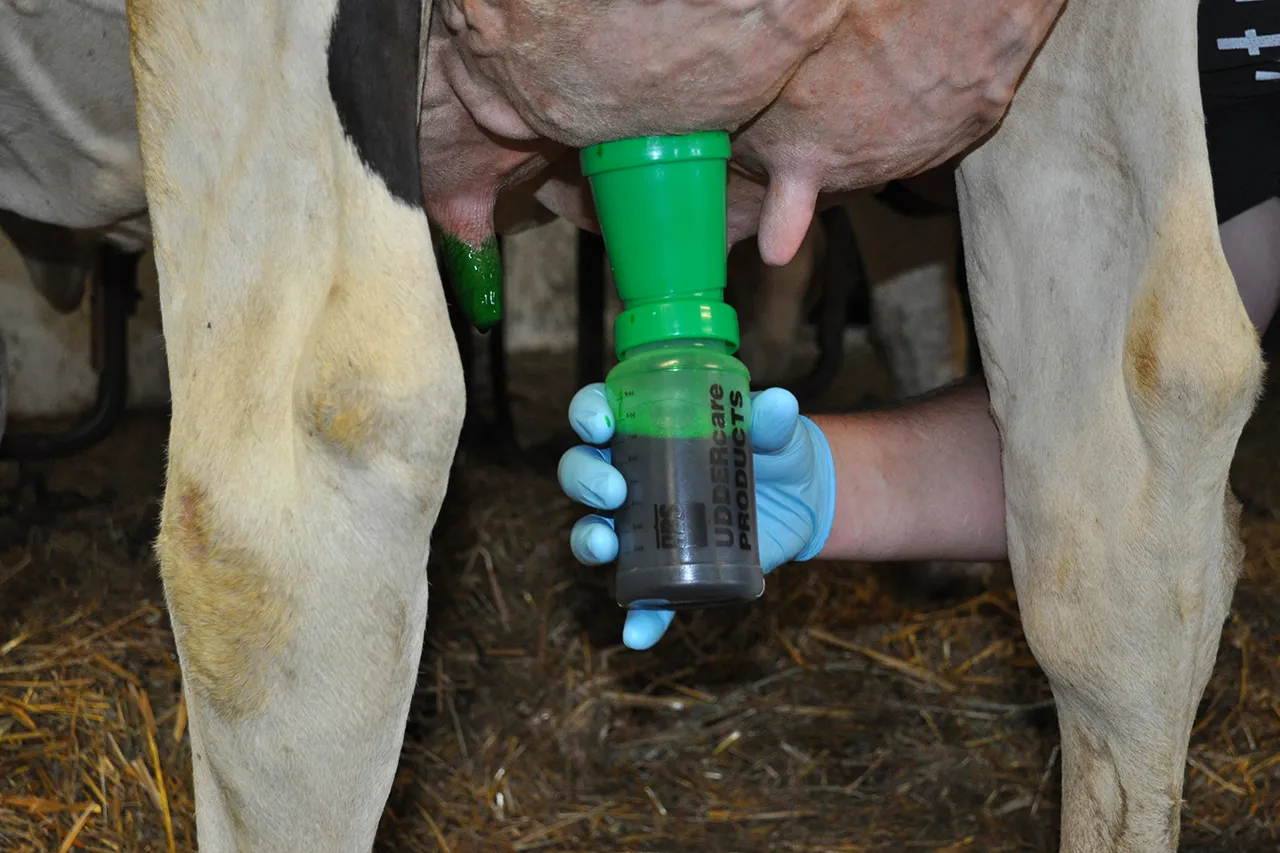Are you using the right teat dip for your dairy farm? Discover how to choose the best one to prevent mastitis, save money, and ensure high-quality milk production.

Have you thought about the significant influence the teat dip you apply has on your dairy farm? The condition of your cows and the quality of your milk output depend much on this little choice. Not only are teat dips essential, but they also serve as the first line of protection against mastitis, a disorder directly influencing production and quality. Join us as we bust common misconceptions regarding teat dips and help you decide which best fits your farm. The proper mix improves the quality of your milk, your dairy’s profitability, and your herd’s general state. Come along as we dispel misconceptions and provide practical guidance on choosing the best teat dip for your farm. By then, you will be ready to make decisions to safeguard your herd and boost production.
The Role of Teat Dips in Dairy Farming
To protect against infections, teat dips—liquid disinfectants—are applied to dairy cows’ teats before and after milking. These dips, which serve as the first line of defense against mastitis, an inflammatory udder condition, are crucial for dairy farming operations. Their role in reducing the bacteria count on the teat skin not only ensures the production of high-quality milk but also provides a reassuring barrier against illness.
Beyond simple contamination prevention, teat dips are essential for preserving udder health in dairy production. The correct application guarantees uniform coating, forming a barrier against external factors and lowering fissures and sores where germs may flourish. Teat dips can include emollients like glycerin or lanolin to keep the skin flexible and stop dryness and chapping.
Furthermore, teat dips may significantly avoid mastitis, one of the most expensive illnesses in dairy production. Following pre- and post-milking dipping procedures helps farmers improve milk quality while also helping to maintain a low somatic cell count in the milk—an indication of excellent udder health. This monitoring is crucial for securing quality premiums and guaranteeing economic sustainability.
Teat dips are critical for preventing mastitis and enhancing udder health. Farmers can guarantee sound milk output and protect the welfare of their herds by choosing the correct teat dip and consulting milk quality experts.
Debunking the Iodine Myth: Exploring Diverse Germicide Options for Teat Dips
Although most dairy farms believe iodine is the best teat dip germicide, current developments have provided other substitutes with either similar or better effects. For high-yield operations where udder health is critical, chlorhexidine—for example—is hailed for its broad-spectrum antibacterial qualities and long-lasting residual action and known for their efficient cleaning and mildness on teat skin, hydrogen peroxide-based dips shine, especially in challenging weather or with sensitive animals.
Furthermore, lactic and salicylic acids are well-known for their quick action and adaptability in various surroundings. These substitutes challenge iodine’s supremacy and let dairy producers choose the most suitable germicide for their situation, improving udder health and milk quality.
Eventually, the emphasis should be on knowing the many germicides accessible rather than depending only on iodine. This will help dairy producers make wise judgments that guarantee their teat dips fit their particular agricultural environment.
The Synergy Between Germicides and Emollients: Ensuring Comprehensive Teat Health
Any conscientious dairy farmer must realize that a germicide in a teat dip only counts somewhat. Although they destroy microorganisms well, germicides cannot guarantee the cow’s teats’ general protection. Emollients then become necessary.
Emollients assist in preserving and rebuilding the skin’s natural barrier. Varying weather and frequent milking may dry and split teats, increasing their infection susceptibility. Emollients improve cow comfort by keeping the teat skin smooth and less injury-prone, avoiding pathogen entry into the udder.
Formulating a teat dip requires balancing emollients and germicides to improve effectiveness. The proper proportion guarantees that the germicide kills dangerous bacteria without compromising the integrity of the skin. Specific formulas, for instance, have a vivid green hue that ensures coverage and efficacy for apparent assurance of appropriate dipping.
A premium teat dip, made under Good Manufacturing Practices (GMPs), aggregates these elements to provide complete protection. GMPs ensure that the teat dip is produced in a clean and controlled environment, free from contamination. Regular assessment of dipping techniques and full execution of dipping rules help strengthen this protection, improving udder health and producing better-quality milk.
Dispelling the One-Size-Fits-All Myth: Tailoring Teat Dip Formulas to Individual Farm Needs
Many people think that the same teat dip recipes apply everywhere. However, this needs to include the particular requirements of every dairy. Herd size, environmental factors, and specific farm needs vary substantially. A method perfect for a small farm may not work well for a large-scale business. Larger herds could require stronger germicides, whereas smaller farms might concentrate on emollients for improved skin conditions.
Another very vital factor is the weather conditions. While farms in humid climates may need moistening dips to avoid chapping, farms in brutal winters might need fast-drying dips to prevent frostbite. Customizing the teat dip to the particular situation of your farm guarantees good disinfection and enhances teat health.
Think through your farm’s particular requirements. While some might find recipes suited for all-year-round housed herds, others would benefit from colored dips for visual coverage checks. By tackling these many elements, farmers may pick the best teat dip, thus improving udder health, keeping low somatic cell counts, and guaranteeing top-notional milk output.
Strategic Teat Dip Selection: Safeguarding Herd Health and Maximizing Dairy Farm Profitability
Selecting the correct teat dip to protect your herd against mastitis is crucial. Customizing the mixture to fit your farm’s environmental demands guarantees good teat protection and sanitization. In winter, a fast-drying cream decreases chapped teats, lowering infection risk. The complete coating reduces the likelihood of bacteria entering the teat canal by dipping or spraying.
Economically, a good teat dip may result in huge savings. Reasonable mastitis control helps to lower veterinarian expenses and the necessity for culling resulting from ongoing infections. Reduced mastitis instances assist in preserving and improving milk production and quality. Udder health depends on a low somatic cell count (SCC), affecting milk quality and influencing farm profitability, which may attract premium prices. This financial benefit should motivate you to make strategic teat dip selections.
Using items based on good manufacturing standards (GMPs) guarantees consistent performance. Frequent updates to pre- and post-dip treatments support udder health all year round. A local milk quality professional may provide customized advice, achieving a balanced approach to mastitis avoidance, cost savings, and maximum milk output.
The Critical Importance of Choosing the Right Teat Dip: Science and Real-World Evidence
Dairy producers trying to preserve herd health and maintain milk quality must choose the appropriate teat dip. Mastitis may be much reduced using teat dips created based on scientific study. For instance, studies supported by data showed that teat dips significantly reduced mastitis cases and enhanced udder health, lowering somatic cell numbers.
Actual instances confirm this. Six months after changing to a scientifically validated teat dip, a Midwest dairy farm saw mastitis cases decline from 12 to three per month. This action also improved their milk quality premiums, demonstrating the sensible advantages of well-informed judgments.
Certain clinical benefits from using teat dips have been confirmed. Farmers improve herd health and structure their activities to be successful in the long term. See a local hygiene and milk quality professional to identify a proven teat dip catered to your farm’s requirements.
Harnessing Expertise: The Vital Role of Local Hygiene and Milk Quality Specialists
Depends on local hygiene and milk quality experts’ output. These professionals provide customized recommendations based on every farm’s circumstances and difficulties. Their observations guarantee that your teat dip schedule is ideal for optimal efficacy, helping fight certain infections and adapt formulas for each season. Before altering your teat dip schedule, it is highly advisable to consult these experts to avoid mastitis, save expenses, and maintain a low somatic cell count.
The Bottom Line
High-quality milk production and herd health depend on ensuring the teat dip is used most effectively. Dairy farmers may limit mastitis incidence and optimize profitability by eliminating iodine fallacies, knowing the synergy between germicides and emollients, and avoiding a one-size-fits-all strategy. Iodine is not always the best choice, even if it is conventional. Teat health depends on the interaction between germicides and emollients. Hence, customized teat dip formulations are essential considering every farm’s situation. See local hygienic and milk quality experts and use items with scientific backing. Effective farm management depends on strategic teat dip choices, influencing operating costs, herd health, and milk quality premiums. A good dairy runs on an educated, customized strategy alone. See your local hygienic and milk quality professional to guarantee the optimal teat dip for your farm’s requirements, avoiding mastitis and promoting a healthier herd.
Consult your local milk quality and hygienic professional to ensure you utilize the best teat dip. Using the correct strategy guarantees a better future for your dairy farm and the prevention of mastitis. Your decision on the appropriate teat dip now goes beyond immediate advantages to open the path for consistent herd health, better milk quality, and more income.
Key Takeaways:
- Teat dip selection aligns directly with the production of high-quality milk and the minimization of mastitis incidence.
- Effectiveness varies by formula, farm conditions, and pathogen strains, necessitating tailored choices over generic solutions.
- Research-backed teat dips offer proven efficacy, making scientific validation a critical factor in selection.
- Diverse germicides beyond iodine present viable options, broadening choices for specific farm needs and pathogen challenges.
- The synergy of germicides and emollients is essential for comprehensive teat health, not just pathogen eradication.
- Engaging local hygiene and milk quality specialists ensures informed decisions, optimizing herd health and profitability.
- Clinical testing under experimental and natural conditions confirms the real-world applicability and effectiveness of teat dips.
- Regular veterinary observations are pivotal in monitoring teat conditions and adjusting protocols as needed.
- Understanding that every farm is unique, pushing against the one-size-fits-all myth, and preemptively assessing specific needs improve outcomes.
Summary:
Teat dips are essential in dairy farming to protect against infections and mastitis. They reduce bacteria count on the teat skin, ensuring high-quality milk production and providing a reassuring barrier against illness. Emollients like glycerin or lanolin help keep the skin flexible and prevent dryness and chapping. Farmers must follow pre- and post-milking dipping procedures to improve milk quality and maintain low somatic cell count. Good Manufacturing Practices (GMPs) ensure clean and controlled production. Customizing teat dip formulas to individual farm needs is crucial for udder health, low somatic cell counts, and maximum milk output. A good teat dip can result in significant savings, as it helps lower veterinarian expenses and the need for culling due to ongoing infections.












